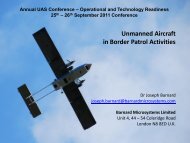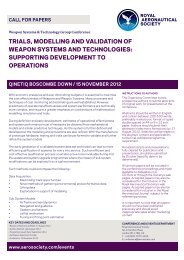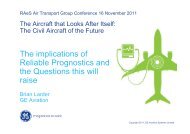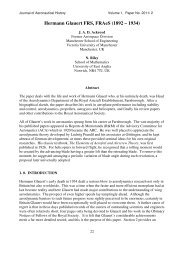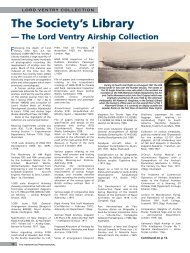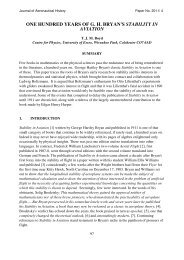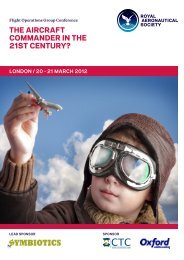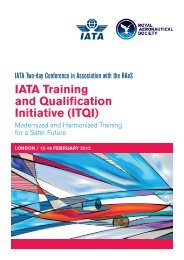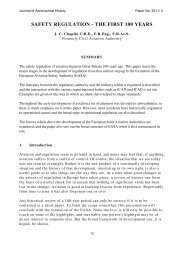Air to Air Refuelling in Civil Aviation, An Opportunity & A Vision Dr ...
Air to Air Refuelling in Civil Aviation, An Opportunity & A Vision Dr ...
Air to Air Refuelling in Civil Aviation, An Opportunity & A Vision Dr ...
You also want an ePaper? Increase the reach of your titles
YUMPU automatically turns print PDFs into web optimized ePapers that Google loves.
Fig. 32 shows possible options. Reverse tank<strong>in</strong>g<br />
(tanker beh<strong>in</strong>d the receiver) with boom and<br />
receptacle may well be the preferred option. The<br />
tanker aircraft will do all the position<strong>in</strong>g and control<br />
work whilst the receiver aircraft cont<strong>in</strong>ues on its<br />
way. There have been many recent advances <strong>in</strong><br />
AAR systems e.g. <strong>in</strong> differential GPS and<br />
au<strong>to</strong>nomous refuell<strong>in</strong>g, RARO, night vision etc. as<br />
mentioned <strong>in</strong> previous papers<br />
Fig. 33 shows various tanker capabilities (fuel<br />
off-load and radius) currently envisaged by the<br />
military. The civil <strong>in</strong>terest will be over a range of<br />
about 1000nm (radius 500nm).<br />
4.6. Phas<strong>in</strong>g <strong>in</strong> AAR<br />
This is related <strong>to</strong> the time and f<strong>in</strong>ances available.<br />
A worldwide network of bases for tanker operations<br />
can be envisaged. This would serve airl<strong>in</strong>es us<strong>in</strong>g<br />
3000 nm range aircraft equipped with AAR<br />
recep<strong>to</strong>rs. At present, opera<strong>to</strong>rs tend <strong>to</strong> fall <strong>in</strong><strong>to</strong><br />
various categories: Cargo, Passenger, Passenger and<br />
Cargo, Domestic (short haul), International (short<br />
and long haul), National (“Flag carriers”) and<br />
privately f<strong>in</strong>anced. Some diversity will exist with<br />
the <strong>in</strong>troduction of civil AAR. A small carrier,<br />
equipped with short <strong>to</strong> medium range aircraft, could<br />
buy-<strong>in</strong> AAR services and offer long-haul flights.<br />
The AAR services may operate along the same<br />
economic pr<strong>in</strong>ciples as airport and ATC services.<br />
Based on figures already <strong>in</strong>troduced, each<br />
tanker, <strong>in</strong> a day, can undertake 8 <strong>to</strong> 12 flights and<br />
service 20 <strong>to</strong> 30 aircraft. ICAO world airl<strong>in</strong>e data<br />
<strong>in</strong>dicated 1,672,000,000 passenger movements<br />
worldwide <strong>in</strong> 2000, <strong>to</strong>gether with 33,500,000 <strong>to</strong>nnes<br />
of cargo. We assume that 25% of the passenger and<br />
50% of the cargo departures were long haul (6000<br />
nm). Us<strong>in</strong>g our 3000 nm aircraft with AAR for<br />
these long haul operations we would need 3,260<br />
AAR operations daily. This equates <strong>to</strong> a global fleet<br />
of about 160 tankers. Such estimates can be further<br />
ref<strong>in</strong>ed <strong>in</strong> due course.<br />
The civil AAR operations will be phased <strong>in</strong> over<br />
a period of time. It would be prudent <strong>to</strong> commence<br />
with cargo aircraft <strong>to</strong> build up public confidence for<br />
accept<strong>in</strong>g the new procedures. Dur<strong>in</strong>g this<br />
<strong>in</strong>troduc<strong>to</strong>ry phase, AAR service suppliers would<br />
beg<strong>in</strong> <strong>to</strong> generate f<strong>in</strong>ances, thereby encourag<strong>in</strong>g<br />
f<strong>in</strong>ancial <strong>in</strong>terest.<br />
It is possible that a cargo carrier would seize the<br />
opportunity of provid<strong>in</strong>g the tanker services,<br />
especially if they already had operational /<br />
ma<strong>in</strong>tenance bases, strategically placed along the<br />
long-haul routes.<br />
The United States Transportation Command<br />
(USTRANSCOM) coord<strong>in</strong>ates the movement of<br />
materials and supplies worldwide for the US<br />
military. <strong>Air</strong>craft used for these operations <strong>in</strong>clude<br />
the C-5 and the C-17. Frequent use is made of AAR<br />
for the longer ranges. A proof of concept and <strong>in</strong>itial<br />
evaluation of AAR <strong>in</strong> civil aviation <strong>to</strong> reduce fuel<br />
consumption could be undertaken by the military.<br />
Market Forecasts<br />
Us<strong>in</strong>g the latest Boe<strong>in</strong>g Studies (Ref.15), one<br />
can conjecture with AAR, a change <strong>in</strong> the new<br />
deliveries at least, See Table 1. There is always<br />
6<br />
need for more detailed work <strong>in</strong>clud<strong>in</strong>g fuel sav<strong>in</strong>gs<br />
and costs!<br />
In the above forecasts for 2027, 3,890<br />
Freighters are <strong>in</strong>cluded. These comprise 35%<br />
standard body (80 <strong>to</strong>nnes).<br />
With AAR, the Tw<strong>in</strong>-Aisle aircraft needed will<br />
be the smaller range versions, either modified or<br />
new (more fuel efficient with <strong>in</strong>creased payloads,<br />
pax + cargo). These will affect the S<strong>in</strong>gle-aisle<br />
numbers also. About 200 Tankers will be added.<br />
_<br />
5. CASE STUDIES AND COST<br />
IMPLICATIONS<br />
We consider a set of scenarios as illustrated <strong>in</strong><br />
Fig.33. Depicted are possible routes (a, b and c) and<br />
tanker base locations.<br />
(a) Based at <strong>An</strong>chorage<br />
North America <strong>to</strong> Asia could utilise AAR<br />
operations based at <strong>An</strong>chorage. This is one of the<br />
busiest International air cargo airports, with 2.15<br />
Million Tonnes handled <strong>in</strong> 2005. This gives an idea<br />
of the scale of operations pass<strong>in</strong>g through / over<br />
<strong>An</strong>chorage. Typical distances are Tokyo <strong>to</strong><br />
<strong>An</strong>chorage, about 3000 nm and <strong>An</strong>chorage <strong>to</strong> New<br />
York, 2935 nm.<br />
(b) Europe <strong>to</strong> Australia<br />
This would allow an airl<strong>in</strong>er <strong>to</strong> depart, for<br />
example, from London with a full complement of<br />
passengers and freight and fly non-s<strong>to</strong>p <strong>to</strong> Sydney.<br />
It could take off us<strong>in</strong>g de-rated thrust, climb quickly<br />
<strong>to</strong> best cruis<strong>in</strong>g altitude and use AAR <strong>to</strong> achieve a<br />
direct flight. Avoid<strong>in</strong>g a technical s<strong>to</strong>p would help<br />
<strong>in</strong> potentially halv<strong>in</strong>g the life-cycle costs and<br />
extend<strong>in</strong>g its service life.<br />
This case follows the example of the 9000nm<br />
aircraft potentially sav<strong>in</strong>g 40% fuel.<br />
(c) US West Coast <strong>to</strong> Australia<br />
West coast USA <strong>to</strong> Australia could use the old<br />
“Fly<strong>in</strong>g Clipper” routes of PAA - Honolulu, Guam,<br />
Nadi, etc as tanker bases. Typical distances <strong>in</strong> this<br />
region are Los <strong>An</strong>geles <strong>to</strong> Honolulu, 2220 nm and<br />
Nadi <strong>to</strong> Sydney 1710 nm. The early “Fly<strong>in</strong>g<br />
Clippers” pioneered such routes.<br />
<strong>An</strong> Example with Freighters, B747F & B767F<br />
The B747-400F, operat<strong>in</strong>g close <strong>to</strong> Pt B<br />
(MTOW), can carry a payload of 123,000 lb over<br />
7,200 nm. At reduced TOW, it can carry twice that<br />
payload over 3600. The B767-300F, at Pt A, carries<br />
123,000 lb over 3,300 nm. Us<strong>in</strong>g various<br />
comb<strong>in</strong>ations of aircraft and payloads we note, <strong>in</strong><br />
Table 2, fuel sav<strong>in</strong>gs afforded by AAR. Tanker fuel<br />
has been taken <strong>in</strong><strong>to</strong> account, RT = 4.<br />
<strong>Refuell<strong>in</strong>g</strong> the B767-300F with 88,451 lb and<br />
later ‘<strong>to</strong>pp<strong>in</strong>g-up’ with 16,082 lb is not the most<br />
efficient scenario or use of tankers. Greater sav<strong>in</strong>gs<br />
could be achieved with alternative arrangements,<br />
e.g. tak<strong>in</strong>g off light and refuell<strong>in</strong>g <strong>to</strong> maximum<br />
capacity twice, or naturally, more efficient aircraft.<br />
In addition <strong>to</strong> the DOC estimates we currently<br />
employ for civil passenger aircraft, it would be<br />
useful <strong>to</strong> have some idea of two associated tanker<br />
costs. The first of these is the tanker operat<strong>in</strong>g cost<br />
per hour. This could be derived from military<br />
figures with a conversion <strong>to</strong> civil operations. The



